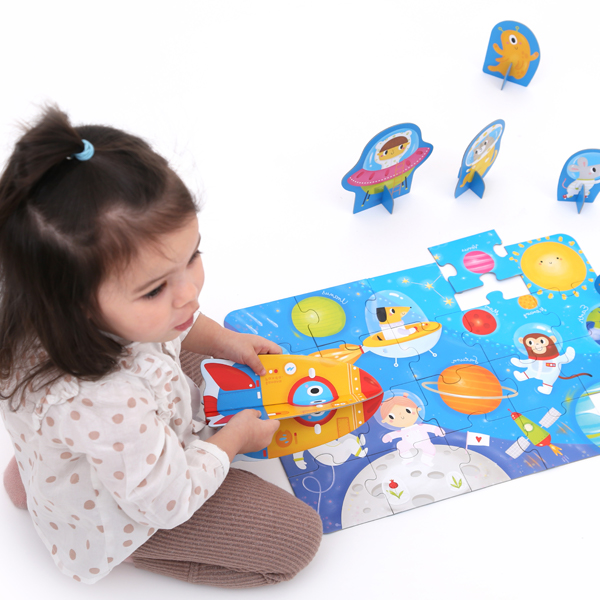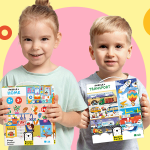Send your child into outer space!
Some time ago, it was reported that a teenage intern from NASA had helped to discover a new planet. Hearing about someone who was able to make such a spectacular discovery at such a young age, it makes you wonder what made him interested in learning about the universe in the first place. Maybe his journey began on the floor of his childhood bedroom with a cosmic toy or game?
In July, we celebrate another anniversary of the Moon landing. This is a great opportunity to look at the sky, prepare books and toys on space and learn something new with your child. We have prepared a practical collection for introducing your child to space as well as ideas for games to stimulate their imagination. Let’s shoot for the stars!
Space Facts for Kids: Moon Landing
We begin our space journey with a visit to our closest neighbor. The Moon is the Earth’s only natural satellite. On July 20, 1969, US astronauts landed on the Moon. Neil Armstrong was the first man to stand on the moon surface after a flight lasting more than 3 days. He, the other astronauts and their vehicles left many traces on the Silver Globe that will not disappear for thousands of years, as well as various souvenirs: US flags, a family photo and even … golf balls. To date, only 12 people have walked on the Moon.

Fun facts about space for children
We’re ready to answer stellar questions such as “What’s that?”, “Why?” and “How is that possible?!” We could talk about space forever – just like the universe, human curiosity about the universe is boundless! We have selected a few topics that will appeal to children and stimulate their imaginations:
- Here is proof of just how powerful children are! Did you know that the name Pluto was invented by a girl? When the new planet was discovered in 1930, 11-year-old Venetia Burney suggested its name. Currently, Pluto is considered a dwarf planet.
- Space probes are unmanned ships that fly through space, collecting information and sending it to Earth. These devices allow us to discover places where human beings cannot yet travel.
- In space, liquid behaves completely different than on Earth! If someone spills liquid on a spaceship, it will not fall to the floor, but assumes a droplet or spherical shape and floats through the air. That is why it is so difficult for astronauts in the space station to wash…
- Astronauts must wear special suits to protect them from cold, heat and radiation. They carry oxygen in their backpacks. One spacesuit weighs as more than 100 juice cartons, but in outer space an astronaut does not feel its weight.
- Jupiter is the biggest planet of the Solar System. The Red Spot visible on its surface is a huge whirlwind. Jupiter holds many records in our Solar System: it has at least 67 moons! Saturn has beautiful distinctive rings. Despite its enormous size, it is so light that it would float on the surface of water (if we could find such a gigantic ocean!). Scientists suspect that it rains diamonds on Uranus.
- Sometimes you can find rocks on Earth that originated in outer space. They are called meteorites. The largest found to date was discovered in Africa. It weighed about as much as 10 elephants!



Toys for space fans
There is an explorer inside every child – expose them to the wonders of space and support their interests. Join in the fun: it’s never too early to explore the universe together! Fun for children and parents can include:
- Watching the sky together – especially in summer when the weather is pleasant. Maybe you will be able to spy the planets through a telescope? Saturn’s rings look spectacular!
- Reading books on space subjects together, searching for information about constellations, planets, and stars.
- Learning about the space explorers – researchers, scientists, astronomers and astronauts thanks to whom we know so much about space today. Finding out more about spacecraft, satellites, telescopes and other tools that have helped to expand our knowledge.
- Designing and building space ships and rovers from blocks, cardboard, paper and other commonly available materials. Who wants to become an engineer?
- Drawing – maybe you’ll design your own aliens? Or will your imagination help you to craft images of distant, still unseen planets? Get inspired – check out Looong Coloring Books Space, which are full of fun illustrations and fascinating puzzle tasks for preschoolers
- Trying to figure out space riddles – even the youngest children are hungry for knowledge about the universe. A wealth of inspiring cosmic curiosities can be found in the educational Peek-a-Boo Riddles 4+ book.
- Assembling space-themed puzzles – let them inspire you to play and make your own discoveries!
- The Figure It Out Puzzle Space 2+ educational set includes puzzles, figurines and game ideas. This is the perfect first step into space for little ones! Fascinating illustrations and large figures encourage you to role-play and pretend to be cosmic heroes. This engaging fun encourages children to become interested in space and voice their first questions about the universe.
- The Observation Puzzle Space for children aged 4+ is a multi-element puzzle for older explorers with a frame full of details to find. The richly detailed, humorous illustration inspires your child to ask serious questions. Selected fun facts from the educational poster are presented above.
- The Suuuper Size Puzzle Solar System is a huge 300-piece puzzle that presents the Solar System, celestial bodies and other objects, and researchers and scientists in more detail. The interesting facts provided on the oversized poster allow you to systematize the space knowledge your child has already acquired and inspire further research. They will familiarize you not only with planets and moons, but also explorers and scientists.
Suuuper Size Puzzle Solar System was chosen as one of the Best Space Gifts for Kids of Every Age by telescopeguide.org. Want to learn more? See the article and the Astronomy Guide they created.



It’s time to blast off!











